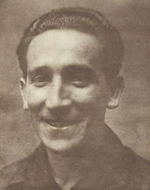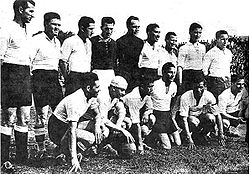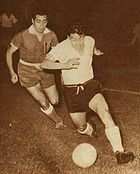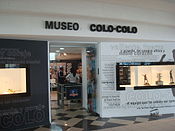- Colo-Colo
-
For other uses, see Colocolo (disambiguation).
Colo-Colo 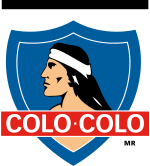
Full name Club Social y Deportivo Colo-Colo[1] Nickname(s) Los Albos (The Snow Whites),
El Cacique (The Cacique),
El Eterno Campeón (The Eternal Champion),
El Popular (The Popular)Founded April 19, 1925 Ground Estadio Monumental David Arellano
Macul, Santiago
(Capacity: 47,000)Chairman Hernan Levy Coach Ivo Basay League Primera División 2011 Apertura 8th Place (Quarter-finals) Home coloursAway coloursClub Social y Deportivo Colo-Colo is a Chilean football club based in the commune of Macul, Santiago. It competes in the Primera División, the top-flight football league in the country, from which they have never been relegated. Their home ground is the Estadio Monumental David Arellano.
Colo-Colo is the most successful team in Chile. They have won a record 29 Primera División titles and 10 Copa Chile. Internationally, they are also the most successful Chilean team having won the Copa Libertadores (1991), the Recopa Sudamericana (1992), and the Copa Interamericana (1992). Colo-Colo was ranked among the top 30 football clubs by the IFFHS in the 2007 All-Time Club World Ranking.[2] In 2009, IFFHS rated Colo-Colo as Chile's top club of the 20th century and one of the top twenty in South America.[3]
Colo-Colo was founded in 1925 by breakaway players of Magallanes led by David Arellano. They currently stand as being the most supported club in the country[4] and have been managed by Blanco y Negro S.A. since 2005. They have a fierce rivalry with Universidad de Chile as both are the two most supported and successful clubs in the country.
Contents
History
Foundation and amateur era (1925–1932)
David Arellano, the founder of the club.
At the beginning of 1925, Magallanes football club was suffering from an internal institutional crisis, stemming from problems between administrators and a few of the players who wanted to turn the club into a professional entity. A breakdown in negotiations provoked a few of the younger players to resign from the team after encountering opposition from the club's directors, established players, and fans.
After a series of reunions the former club Magallanes players led by David Arellano decided to establish their new club creating Colo-Colo on April 19, 1925. Colo-Colo was named after a Chilean Mapuche chief. The individuals involved included, the Arellano brothers, David and Francisco; Juan Quiñones (who designed the team uniform and colors); Luis Contreras (who came up with the name); Rubén and Nicolás Arroyo; Clemente Acuña; Guillermo Garcés; Rubén Sepúlveda; Eduardo Stavelton; and Luis Mancilla.[5]
The club was victorious upon winning the (Primera División de la Liga Metropolitana) through an unbeaten fashion. This was also the first tournament that Colo-Colo entered and successfully completed. The year 1927 had Colo-Colo as being the first Chilean club team to go on tour across Europe to participate in a round of friendly games. Tragedy struck on the tour when on May 2, 1927, in an exhibition match against Real Valladolid of Spain team captain and founder David Arellano was critically injured after suffering a collision with an opposing player that caused Peritonitis. The inflammation would lead to his death the next day.[6] Despite the huge loss, the club carried on and won the (Primera División de la Liga Central de Football) championships the following three years in 1928, 1929, and 1930.
During the years 1931–32 the club experienced their first institutional crisis when the directors wanted to invest a large amount of money in newer players. The new acquisitions did not render the team any positive results, therefore creating a decrease in salaries throughout the rest of the squad.
On December 8, 1932 Colo-Colo returned to play another championship final against Santiago based club Audax Italiano. As Colo-Colo was winning 2–1, a platform in the Audax Italiano stadium collapsed as fans were trying to rush the field of play. The match was canceled and the champion for that year remained vacant. The tragedy resulted in 130 injuries and 3 deaths.[7]
Professional era
In the early 30s many of the Santiago based clubs in Chile along with Colo-Colo decided to create a professional football league within the country. The league was established in 1933. At the end of the inaugural league both Colo-Colo and Magallanes were tied on points. A decisive final between both clubs were held where Magallanes went on to win 2–1.
Colo-Colo were not able to earn their first national title until 1937. The club did so by winning it that year unbeaten. Colo-Colo won their second national title under the direction of manager Franz Platko. Chilean player Alfonso Dominguez contributed in the championship that year by scoring 20 goals in 24 matches.
In the 1940s while still under the management of Platko, the club obtained a new title in 1941. This was followed by the 1944 and 1947 championships. The latter title served as the basis for the South American Club Championship of 1948 which was organized by Colo-Colo and held in Santiago, Chile. The tournament served as a pre-cursor to the Copa Libertadores.[8]
During the 1950s, under the club presidency of Antonio Laban, the services of Chilean striker Jorge Robledo of Newcastle United were obtained. His performances contributed in Colo-Colo winning the national championships of 1953 and 1956. The latter was the same year in which 28 hectares of territory was acquired by Colo-Colo in the commune of Macul, initiating the construction of the future Estadio Monumental.
The following decade began with the obtainment of the 1960 and 1963 national championships. The 1963 championship was historical in that two records were broken. The first was for the most maximum number of goals scored by a club in a season (103), and the second for the maximum number of goals ever scored in a single season (Luis Alvarez with 37 goals). This year also marked the breaking of tradition of only playing with Chileans since 1944, with the signing of Argentine Walter Jimenez. Until the end of the decade, Colo-Colo were only able to realize irregular national campaigns, which were dominated by both Universidad de Chile and Universidad Católica. The drought ended when Colo-Colo won the 1970 national championship, the club's tenth title.
In 1972 under the technical direction of Luis Alamos, and with focal players Francisco Valdés and Carlos Caszely, Colo-Colo again won the championship. This championship winning team built the foundation of (Colo-Colo '73), the first team from Chile to compete in a Copa Libertadores final, losing to Independiente of Argentina. Soon after, the club entered a sporting and institutional crisis which was solved at least in the sporting aspect with the obtainment of the 1979 national championship.
The decade of the 80s had Colo-Colo winning national titles in 1981 and 1983 under the technical leadership of Pedro Garcia. The championship titles of 1986 and 1989 were under the managerial guidance of Arturo Salah. In this decade Colo-Colo won the Copa Chile on four occasions. Despite the national achievements the club was in debt to their fans for not faring well on the international tournament level. Colo-Colo displayed important victories such as defeating São Paulo away, but were only able to once surpass the group stage of the Copa Libertadores in 1988. At the end of the decade on September, 30 1989, the Estadio Monumental David Arellano was inaugurated.
The 90s went down in club history as being the decade in which Colo-Colo would obtain the most titles including the first ones achieved on an international level. In the middle of 1990 the club would contract the services of Mirko Jozic with whom the team won its first tri-campeonato, Copa Libertadores, Recopa, and Copa Interamericana. After the departure of Jozić, Colo-Colo suffered some years of instability caused by the dispute over the presidency between the factions led by Peter Dragicevic and Eduardo Menichetti and ended with the election of the former and a slow growing debt. These problems were swept under the rug in 1995 with the arrival of Paraguayan coach Gustavo Benitez who led Colo-Colo to win titles in 1996, 1997, and 1998.
The dawn of the new millennium brought a dark period for Colo-Colo, who were officially declared bankrupt in January 2002, though the institution managed to keep its doors open. This status was eventually rescinded in early 2006, around the time of Claudio Borghi's appointment as coach. And in a run that begun under the Argentinian strategist and featured players of the calibre of Matias Fernandez, Jorge Valdivia, Alexis Sanchez, Arturo Vidal, and Humberto Suazo, El Cacique won five of the next six short-tournament titles (Apertura and Clausura) culminating in the 2008 Clausura crown.[9]
Copa Libertadores
Colo-Colo suffered defeat in the 1973 Copa Libertadores final and waited to crown themselves as Copa Libertadores champions 18 years later on June 5, 1991. Colo-Colo played the final against Olimpia Asunción. The first leg, played in Asunción, Paraguay ended in a 0–0 draw. In the second leg Colo-Colo pulled out a 3–0 win, with two goals scored by Luis Pérez who did not have a starting role prior to the game and one by Leonel Herrera who came in as a substitute.
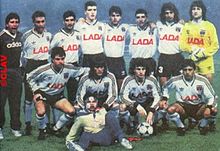 Colo-Colo, the winners of the 1991 edition
Colo-Colo, the winners of the 1991 edition
Crest and colours
The Mapuche cacique, Colo-Colo, is a historic symbol of heroic courage, bravery, and wisdom who fought, never surrendered, and never lost to the Spaniards during the Arauco War. The team colors (white and black) portray the philosophy of the founders: "The white shirt stands as a symbol of purity in principles and intentions and the black of the shorts represents the determination to always fight for victory." The black bar above the badge symbolizes the early death of David Arellano who is remembered for having founded one of the most important teams in Chile.
Supporters
Main article: Garra BlancaSeveral public opinion surveys conducted throughout Chile identify Colo-Colo as the most popular football club in the country. A 1999 survey made by Future Foundation ranked Colo-Colo first with 45.6% of the preference. In a 2008 report commissioned by the National Association of Professional Football (ANFP), among 1,010 people in the 6 most populated urban areas within Chile, 44.7% of the respondents questioned chose Colo-Colo as their primary team.
The diehard fans, "Ultras", "Hinchada" or "Barra", are known as the Garra Blanca (literally "white claw", but "garra" in Spanish also means "fuerza", so the correct translation is "white force"). They are the largest organized group of football fans in Chile. Garra Blanca is known to follow the team and support it in every city and stadium where Colo-Colo plays. Also the "Garra Blanca" is the oldest "barra brava" of the country, it was founded in 1985.
Rescued Chilean miner Omar Reygadas, 56, displayed the flag of Colo-colo as he was being wheeled on a gurney into the medical triage area moments after leaving the rescue capsule.
Rivals
Main article: Chilean football derbyColo-Colo's traditional rival is Universidad de Chile, known in Chile as the Superclásico (Super Classic), Chile's most popular football derby. The first game between the two clubs occurred in 1935. The rivalry began brewing between the decades of the 40s and 50s. November 11, 1954 would be the climax of a series of disagreements between the two clubs. That meeting ended with a victory for Universidad de Chile by a 2 to 1 margin, this being the first in a series of good results for the "blues" against Colo-Colo.
Colo-Colo managed to reverse this trend over the next 21 years, 50 First Division games are recorded between 1970 and 1991, with 26 wins for Colo-Colo, 15 draws and only 9 wins for Universidad de Chile.
Both top clubs have met 167 times with 73 wins for Colo-Colo, 49 draws, and 45 wins for Universidad de Chile. Internationally they have only met twice, with a triumph for Colo-Colo and a draw. Besides having the advantage historically, Colo-Colo are also victorious in obtaining the largest margin of victory between the two by winning 6-0 on August 7, 1938.
Administration
During the first formal session of Colo-Colo, on April 19 of 1925, chaired by John Quiñones, it was agreed that the club was managed by a board headed by a president elected by the members, the first of these Alberto Parodi. In the early 1930s, Colo-Colo suffered its first major crisis, caused mainly by strong financial and institutional problems. Among other measures, the board opted to reduce the costs of the club, to reduce financial incentives to the players the first team, with the consequent resistance from these and some leaders. It is noteworthy that these incentives or remuneration is paid so illegal, considering that at the time the football was an activity officially amateur, in what is called "brown" or hidden professionalism.
To solve the problems of the Corporation, they appointed a committee to reorganize the institution, this being chaired by Fernando Larraín Mancheño. However, at the end of this administration was elected as President Ricardo Cortés Monroy, prompting a strong rejection of the players the first team, who even threatened mass resignations to the club. Later, at the general meeting of January 21 of 1932, some partners said tainted the election of Monroe, designating an interim council to administer the club led by Charles Haupt. However, Fernando Larraín, who in legal terms was still president of the Corporation, requested the intervention of Santiago Football Association (SFA), which took place on January 22 of 1932.
During the two decades after the club had a number of problems, both financial and institutional, noting the resignation of part of the leadership of Alvarez Robinson 1947, who at the time of resignation stated that the club was on the verge of bankruptcy, and as the bribery case which ended with the expulsion of the Central Football Association (JFA) leader Luis Orellana in 1951. Even so, thanks to the efforts of Pedro Foncea and later by Antonio Laban, the club continued its institutional strengthening, expanding their sports activities with the establishment of branches of basketball and skating. It also provided medical and dental services for members, plus a library and several methods of entertainment.
After the departure from Laban in 1962, returned to cause problems within the institution, making the situation untenable to 1968, the year in which members and leaders were divided into two groups, adherents and opponents of then- President Guillermo Herrera. This situation desenvocó in unpaid wages and a strike by players. Finally, the ACF (ANFP since 1987) the Corporation intervened February 8 of 1968.
After renegotiating the debt in late 1969, the club's management was returned to members Héctor Gálvez assuming the presidency, a position he held until 1976. That year, the election for president of the club faced with Antonio Laban Héctor Gálvez, former club president who had the support of the president of the National Association of Public Employees (ANEF) Tucapel Jiménez, known opponent of military dictatorship. In this situation, the state agency sports DIGEDER decided to refuse permission for conduct of elections. On April 2 of 1976 Policy Colo-Colo was formally dismissed by the government, handing the administration of the economic group BHC Corporation. To justify the intervention was argued that there were irregularities at the club for an amount close to U.S. $ 300,000 of the time. However, the failure of the project that sought to make football clubs corporations, coupled with the debt that was dragging the club for the construction of structural works for the Monumental Stadium, led to BHC, who had been one of the initiators of aforementioned project, leave administration, leaving the club mired in serious economic problems. Finally, on January 31 the Central Football Association intervened again to the Corporation. During the first half of the year 1980, the debts he contracted the club generated a severe crisis, which was solved in part through financial assistance from the State Bank and a contract with National Television of Chile for the rights to broadcast matches.
After little more than a decade of relative calm, time in which he highlighted the increase of the club in the late nineties New economic problems, caused mainly by the inability of the club to keep the big income received in early the decade, and the huge spending on players and coaches. Finally, the Corporación Club Social y Deportivo Colo-Colo was declared bankrupt on January 23 of 2002, with debts of close to $ 22.000.000.000 (about U.S. $ 30,000,000), 62 assuming a club management trustee in bankruptcy. During this process, the institution suffered the sale of much of its heritage, including the clubhouse and the Teatro Monumental, which went to auction, and the elimination of non-professional branches and research institute for players the club. After various initiatives, among which was the sale of all assets of the club, including the Estadio Monumental, and their transformation into joint-stock company (project called "White Rebirth"), it was decided to deliver the club's management concession the company Black & White SA, for a period of 30 years, the grant being approved by the creditors' meeting on March 29 of 2005.
Finally, the June 24 contract closed between the Corporación Club Social y Deportivo Colo-Colo and Blanco y Negro S.A., from the latter to manage all assets of the club and began operations on July 1 of 2008. Since then, the partners have ceased direct involvement in management decisions of the club, only to receive benefits in economic terms, as the reduction in ticket prices. Moreover, the loss of much of the premises of the club for bankruptcy, make this not have facilities for the corporate mass. Notwithstanding the foregoing, it is noteworthy that the Corporation continues to exist as such and keeps the right to elect two members of the board of Blanco y Negro.
Since March 2011, the office of President of Blanco y Negro S.A. is exercised by Hernan Levy, who replaced William Mackenna.
Kits 2011
Home Away Libertadores Home Libertadores Away Players
Current squad
As of July 26, 2011[10]
Number Player Playing Position Height Age Club From Since Until Observations 1  Juan Guillermo Castillo
Juan Guillermo CastilloGoalkeeper 1.83 33 Deportivo Cali 2011 2013 International. 2  Christian Vilches
Christian VilchesDefender 1.83 28 Audax Italiano 2011 2013 International. 3  Luis Mena
Luis MenaDefender 1.78 33 Youth System 1996 2013 4  Álvaro Ormeño
Álvaro OrmeñoDefender 1.71 32 Gimnasia LP 2011 2013 International. 5  Osmar Molinas
Osmar MolinasMidfielder 1.80 24 Olimpia 2011 2013 6  Mario Salgado
Mario SalgadoForward 1.86 30 Torino 2011 2013 7  Esteban Paredes
Esteban ParedesForward 1.81 31 Santiago Morning 2009 2013 International. 9  Joan Muñoz
Joan MuñozMidfielder 1.78 21 O'Higgins 2011 2013 10  Marco Medel
Marco MedelMidfielder 1.77 22 Audax Italiano 2011 2012 International. 11  Carlos Muñoz
Carlos MuñozForward 1.74 22 Santiago Wanderers 2011 2013 International 12  Raúl Olivares
Raúl OlivaresGoalkeeper 1.85 23 Unión San Felipe 2008 2013 13  José Pedro Fuenzalida
José Pedro FuenzalidaMidfielder 1.71 26 O'Higgins 2008 2013 International 14  Rodrigo Millar
Rodrigo MillarMidfielder 1.83 30 Huachipato 2007 2012 International 15  Boris Rieloff
Boris RieloffDefender 1.86 27 Gimnasia LP 2011 2013 16  Mauro Olivi
Mauro OliviForward 1.71 28 Audax Italiano 2011 2015 18  Lucas Wilchez
Lucas WilchezMidfielder 1.72 28 Estudiantes de La Plata 2010 2011 19  Andrés Scotti
Andrés ScottiDefender 1.84 35 Argentinos Juniors 2010 2013 International. 20  Matthias Villanueva
Matthias VillanuevaMidfielder 1.78 18 Youth System 2011 2014 21  Bryan Rabello
Bryan RabelloMidfielder 1.63 17 Youth System 2011 2014 22  Roberto Gutiérrez
Roberto GutiérrezForward 1.78 28 Universidad Católica 2011 2013 23  Luis Pavez
Luis PavezMidfielder 1.75 23 Palestino 2010 2013 24  Patricio Jerez
Patricio JerezDefender 1.69 26 Huachipato 2011 2013 22  Francisco Prieto
Francisco PrietoGoalkeeper 1.88 28 Cobreloa 2009 2012 22  Sebastián Toro
Sebastián ToroCentre back 1.78 21 Youth System 2009 2013 International 27  Cristian Magaña
Cristian MagañaCentre back 1.78 20 Youth System 2010 2013 28  Manuel Bravo
Manuel BravoLeft back 1.74 19 Youth System 2011 2014 30  Jorge Aravena
Jorge AravenaMidfielder 1.75 19 Youth System 2011 2014 23  Jorge Troncoso
Jorge TroncosoForward 1.75 19 Youth System 2011 2014 33  Nelson Cabrera
Nelson CabreraCentre back 1.93 28 Cerro Porteño 2009 2012 Coach  Ivo Basay
Ivo BasayManager 1.75 45 O'Higgins 2011 2012 - The teams of the Chilean Primera Division are limited to seven players without Chilean nationality and also are limited to five foreign players in the field. The squads with more of seven players in the squad or five foreign players are sanctioned by the ANFP. The squad of the club now have all places of foreign players, three Argentine players, two Uruguayan players and two Paraguayan player.
Out on Loan
Note: Flags indicate national team as has been defined under FIFA eligibility rules. Players may hold more than one non-FIFA nationality.
No. Position Player — 
GK Eduardo Lobos (at Santiago Wanderers) — 
GK Ignacio González (at Deportes Puerto Montt) — 
DF Bruno Romo (at Palestino) — 
DF Rafael Caroca (at Deportes La Serena) — 
MF Nelson Cereceda (at Deportes Copiapó) — 
MF Gerardo Cortés (at Palestino) — 
MF José Luis Cabión (at Cobresal) No. Position Player — 
MF Johanns Dulcien (at Naval) — 
MF Boris Sagredo (at O'Higgins) — 
MF Daniel González (at Audax Italiano) — 
FW Nicolás Millán (at Naval) — 
FW Phillip Araos (at Coquimbo Unido) — 
FW Cristian Bogado (at Deportes Iquique) Management team
Position Name Manager  Ivo Basay
Ivo BasayAssistant manager 
 Daniel Moron
Daniel MoronField assistant - Fitness coach  Gaston Lloveras
Gaston LloverasGoalkeeping coach  Marcelo Ramírez
Marcelo RamírezMedical Boss  Roberto Yáñez
Roberto YáñezMedical team  Luis Maya
Luis Maya
 Jorge Cheyre
Jorge Cheyre
 Julio César Botello
Julio César BotelloKinesiologists  Alejandro Kock
Alejandro Kock
 Pedro Oñate
Pedro OñateParamedical  Ramón Rivera
Ramón RiveraAcademy team manager  Luis Pérez
Luis PérezStadium
Main article: Estadio Monumental David ArellanoColo-Colo's stadium, Estadio Monumental David Arellano, is located in Macul, Santiago and has a 45,953 capacity. Colo-Colo inaugurated the stadium on September 30, 1989 with a match against Peñarol. The home team went on to win by a final score of 2–1.
Facilities
Construction began in early 2007 of the Casa Alba (White House) to house Colo-Colo's youth players. Casa Alba has an area of 1156.24 square meters and a carrying capacity of 64 youth cadets. The facility includes gyms, dormitories, recreation rooms, and study.
Inaugurated in June 2009, The Colo-Colo museum houses the national championship trophies won by the club, the replica of the Copa Libertadores achieved in 1991, the shirts worn by the club, and a model of the stadium. The museum also features special sections dedicated to events such as when Colo-Colo went unbeaten in 1937 and 1941, the Colo-Colo of 1973, the three peat winning championship team between 1989 and 1991, and the 4 time in a row winning championship teams between 2006 and 2007.[11]
Honours
- Local
- Liga Central de Football (3): 1925, 1928, 1929
- Asociación de Football de Santiago (1): 1930
- National
- Primera Division (29): 1937, 1939, 1941, 1944, 1947, 1953, 1956, 1960, 1963, 1970, 1972, 1979, 1981, 1983, 1986, 1989, 1990, 1991, 1993, 1996, 1997 Clausura, 1998, 2002 Clausura, 2006 Apertura, 2006 Clausura, 2007 Apertura, 2007 Clausura, 2008 Clausura, 2009 Clausura
- Copa Chile (10): 1958, 1974, 1981, 1982, 1985, 1988, 1989, 1990, 1994, 1996
- International
- Copa Libertadores de América
- Winners (1): 1991
- Runners-up (1): 1973
- Recopa Sudamericana
- Winners (1): 1992
- Copa Interamericana
- Winners (1): 1991
- Intercontinental Cup
- Runners-up (1): 1991
- Copa Sudamericana
- Runners-up (1): 2006
Player records
Primera División Topscorers
 Luis Carvallo: 9 (1933)
Luis Carvallo: 9 (1933) Aurelio Domínguez: 12 (1935)
Aurelio Domínguez: 12 (1935) Alfonso Domínguez: 32 (1939), 19 (1944)
Alfonso Domínguez: 32 (1939), 19 (1944) George Robledo: 26 (1953), 25 (1954)
George Robledo: 26 (1953), 25 (1954) Luis Hernán Alvárez: 37 (1963)
Luis Hernán Alvárez: 37 (1963) Julio Crisosto: 28 (1974)
Julio Crisosto: 28 (1974) Carlos Caszely: 20 (1979), 26 (1980), 20 (1981)
Carlos Caszely: 20 (1979), 26 (1980), 20 (1981) Rubén Martínez: 22 (1990), 23 (1991)
Rubén Martínez: 22 (1990), 23 (1991) Anibal González: 24 (1992)
Anibal González: 24 (1992) Héctor Tapia: 24 (2001)
Héctor Tapia: 24 (2001) Sebastián González: 18 (2002 Apertura)
Sebastián González: 18 (2002 Apertura) Manuel Neira: 14 (2002 Clausura)
Manuel Neira: 14 (2002 Clausura) Gonzalo Fierro: 13 (2005 Clausura)
Gonzalo Fierro: 13 (2005 Clausura) Humberto Suazo: 19 (2006 Apertura)
Humberto Suazo: 19 (2006 Apertura) Humberto Suazo: 18 (2007 Apertura)
Humberto Suazo: 18 (2007 Apertura)
 Lucas Barrios: 19 (2008 Apertura)
Lucas Barrios: 19 (2008 Apertura)
 Lucas Barrios: 18 (2008 Clausura)
Lucas Barrios: 18 (2008 Clausura)
International Topscores
 Carlos Caszely: 9 (1973 Copa Libertadores)
Carlos Caszely: 9 (1973 Copa Libertadores) Humberto Suazo: 10 (2006 Copa Sudamericana)
Humberto Suazo: 10 (2006 Copa Sudamericana) Matías Fernández: 9 (2006 Copa Sudamericana)
Matías Fernández: 9 (2006 Copa Sudamericana)
The World's Top Goal Scorer
 Humberto Suazo: 35 (2006)
Humberto Suazo: 35 (2006)
 Lucas Barrios: 37 (2008)
Lucas Barrios: 37 (2008)
South American Player of the Year
 Gabriel Mendoza (1991)
Gabriel Mendoza (1991) Marco Antonio Etcheverry (1993)
Marco Antonio Etcheverry (1993) Matías Fernández (2006)
Matías Fernández (2006) Humberto Suazo (2006)
Humberto Suazo (2006)
South American Footballer of the Year
 Matías Fernández (2006)
Matías Fernández (2006)
Notable players
 Héctor Adomaitis (1992, 2000)
Héctor Adomaitis (1992, 2000) Claudio Borghi (1992)
Claudio Borghi (1992) Sebastián Cejas (2006–07)
Sebastián Cejas (2006–07) Ricardo Dabrowski (1987–92)
Ricardo Dabrowski (1987–92) Marcelo Espina (1995–98, 2001–04)
Marcelo Espina (1995–98, 2001–04) René Houseman (1982)
René Houseman (1982) Marco Etcheverry (1994)
Marco Etcheverry (1994) Emerson Pereira (1995–98, 2000)
Emerson Pereira (1995–98, 2000) Severino Vasconcelos (1978–83)
Severino Vasconcelos (1978–83) Miguel Aceval (2001–06, 2007)
Miguel Aceval (2001–06, 2007) Sergio Ahumada (1970–74)
Sergio Ahumada (1970–74) Luis Hernán Álvarez (1958–65)
Luis Hernán Álvarez (1958–65) David Arellano (1925–27)
David Arellano (1925–27) Francisco Arrué (1994–99)
Francisco Arrué (1994–99) Fernando Astengo (1986)
Fernando Astengo (1986)
 Marcelo Barticciotto (1988–92, 1996–02)
Marcelo Barticciotto (1988–92, 1996–02) Ivo Basay (1995–99)
Ivo Basay (1995–99) Claudio Bravo (2002–06)
Claudio Bravo (2002–06) Víctor "Pititore" Cabrera (1985)
Víctor "Pititore" Cabrera (1985) Carlos Caszely (1967–73, 1978–83, 1985–86)
Carlos Caszely (1967–73, 1978–83, 1985–86) Roberto Cereceda (2007–10)
Roberto Cereceda (2007–10) Jorge Contreras (1993–94)
Jorge Contreras (1993–94) Pablo Contreras (1996–99)
Pablo Contreras (1996–99) Nicolás Córdova (1997–00)
Nicolás Córdova (1997–00) Humberto Cruz (1963–71)
Humberto Cruz (1963–71) Mauricio Donoso (2003–05)
Mauricio Donoso (2003–05) Misael Escuti (1946–64)
Misael Escuti (1946–64) Jorge Espinoza (1972–79)
Jorge Espinoza (1972–79) Rubén Espinoza (1989–91)
Rubén Espinoza (1989–91) Fabián Estay (1995–96)
Fabián Estay (1995–96) Matías Fernández (2004–06)
Matías Fernández (2004–06) Gonzalo Fierro (2002–08)
Gonzalo Fierro (2002–08) Elías Figueroa (1982)
Elías Figueroa (1982) Luis Pedro Figueroa (2008-09)
Luis Pedro Figueroa (2008-09) José Pedro Fuenzalida (2010-)
José Pedro Fuenzalida (2010-) Mario Galindo (1971–75, 1977–82)
Mario Galindo (1971–75, 1977–82) Miguel Ángel Gamboa (1974)
Miguel Ángel Gamboa (1974) Lizardo Garrido (1982)
Lizardo Garrido (1982) Aníbal González (1992, 1994)
Aníbal González (1992, 1994) Rafael González (1969–?)
Rafael González (1969–?) Sebastián González (1998–02, 2009)
Sebastián González (1998–02, 2009) Roberto Gutiérrez (2011-)
Roberto Gutiérrez (2011-) David Henríquez (1995–02, 2003–04, 2005–07)
David Henríquez (1995–02, 2003–04, 2005–07) Leonel Herrera Rojas (1967–74, 1979–86)
Leonel Herrera Rojas (1967–74, 1979–86) Leonel Herrera Silva (1989, 1991, 1993, 1995)
Leonel Herrera Silva (1989, 1991, 1993, 1995)
 Alejandro Hisis (1982–85, 1992)
Alejandro Hisis (1982–85, 1992) Francisco Huaiquipán (2002, 2004)
Francisco Huaiquipán (2002, 2004) Gonzalo Jara (2007–09)
Gonzalo Jara (2007–09) José Luis Jerez (2006-07)
José Luis Jerez (2006-07) Braulio Leal (2000–04, 2005–06)
Braulio Leal (2000–04, 2005–06) Sergio Livingstone (1957)
Sergio Livingstone (1957) Eduardo Lobos (2000–03)
Eduardo Lobos (2000–03) Frank Lobos (1998–99, 2006)
Frank Lobos (1998–99, 2006) Jaime Lopresti (2000–02)
Jaime Lopresti (2000–02) Claudio Maldonado (1998–99)
Claudio Maldonado (1998–99) Rodolfo Madrid (2002-05)
Rodolfo Madrid (2002-05) Héctor Mancilla (2006)
Héctor Mancilla (2006) Javier Margas (1990–95, 1996)
Javier Margas (1990–95, 1996) Rubén Martínez (1990–92)
Rubén Martínez (1990–92) Rodrigo Meléndez (2006–2010)
Rodrigo Meléndez (2006–2010) Luis Mena (1996–)
Luis Mena (1996–) Gabriel Mendoza (1991–96, 2001)
Gabriel Mendoza (1991–96, 2001) Sergio Messen (1971–74)
Sergio Messen (1971–74) Rodrigo Millar (2007–)
Rodrigo Millar (2007–) Cristián Montecinos (1999)
Cristián Montecinos (1999)
 Daniel Morón (1989–95)
Daniel Morón (1989–95) Carlos Muñoz (2011-)
Carlos Muñoz (2011-) Manuel Muñoz (1949–58)
Manuel Muñoz (1949–58) Raúl Muñoz (1997–02)
Raúl Muñoz (1997–02) Adolfo Nef (1973–80)
Adolfo Nef (1973–80) Manuel Neira (1994–95, 1997–99, 2002–04)
Manuel Neira (1994–95, 1997–99, 2002–04) Alvaro Ormeño (2005–06, 2011-)
Alvaro Ormeño (2005–06, 2011-) Raúl Ormeño (1975–91)
Raúl Ormeño (1975–91) Mario Osbén (1980–85)
Mario Osbén (1980–85) Esteban Paredes (2009–)
Esteban Paredes (2009–) Simón Parra (1966–76)
Simón Parra (1966–76) Jaime Pizarro (1983–93)
Jaime Pizarro (1983–93) Francisco Prieto (2009-)
Francisco Prieto (2009-) Luis Ignacio Quinteros (1996–03)
Luis Ignacio Quinteros (1996–03) Marcelo Ramírez (1984–89, 1991–01)
Marcelo Ramírez (1984–89, 1991–01) Miguel Ramírez (1990–95, 2004–05)
Miguel Ramírez (1990–95, 2004–05) Carlos Reinoso (1970)
Carlos Reinoso (1970) Pedro Reyes (1993–98)
Pedro Reyes (1993–98) Boris Rieloff (2011-)
Boris Rieloff (2011-) Miguel Riffo (2000–2010)
Miguel Riffo (2000–2010) Carlos Rivas (1978–82)
Carlos Rivas (1978–82) Jorge (George) Robledo (1953–58)
Jorge (George) Robledo (1953–58) Ted Robledo (1953–55)
Ted Robledo (1953–55) Francisco Rojas (1994–96, 1997–00)
Francisco Rojas (1994–96, 1997–00) Ricardo Rojas (2008)
Ricardo Rojas (2008)
 Roberto Rojas (1983–87)
Roberto Rojas (1983–87) Sebastián Rozental (2001–02)
Sebastián Rozental (2001–02) Diego Rubio (2011)
Diego Rubio (2011) Eduardo Rubio (2007–08)
Eduardo Rubio (2007–08) Hugo Eduardo Rubio (1986–87, 1991–94, 1995–96)
Hugo Eduardo Rubio (1986–87, 1991–94, 1995–96) Mario Salgado (2011-)
Mario Salgado (2011-) Alexis Sánchez (2006–07)
Alexis Sánchez (2006–07) Leonel Sánchez (1969–70)
Leonel Sánchez (1969–70) Arturo Sanhueza (2005–10)
Arturo Sanhueza (2005–10) José Luis Sierra (1996–98, 1999–01)
José Luis Sierra (1996–98, 1999–01) Humberto Suazo (2006–07)
Humberto Suazo (2006–07) Guillermo Subiabre (1927–34)
Guillermo Subiabre (1927–34) Héctor Tapia (1994–98, 2001, 2005)
Héctor Tapia (1994–98, 2001, 2005) Jorge Toro (1959–62)
Jorge Toro (1959–62) Sebastián Toro (2009-)
Sebastián Toro (2009-) Juan Pablo Úbeda (2003–04)
Juan Pablo Úbeda (2003–04) Francisco Valdés (1961–69, 1972–75)
Francisco Valdés (1961–69, 1972–75) Jorge Valdivia (2003–06)
Jorge Valdivia (2003–06) Dion Valle (1993–95)
Dion Valle (1993–95) Marcelo Vega (1993–95)
Marcelo Vega (1993–95) Jaime Vera (1983–88)
Jaime Vera (1983–88) Fernando Vergara (1994–2000)
Fernando Vergara (1994–2000) Arturo Vidal (2006–07)
Arturo Vidal (2006–07) Eduardo Vilches (1989–94)
Eduardo Vilches (1989–94) Moisés Villarroel (2003–08)
Moisés Villarroel (2003–08) Marco Villaseca (1997-2001, 2003)
Marco Villaseca (1997-2001, 2003) Oscar Wirth (1979–80)
Oscar Wirth (1979–80) Patricio Yáñez (1991–95)
Patricio Yáñez (1991–95) Richard Zambrano (1997–98)
Richard Zambrano (1997–98) Iván Zamorano (2003)
Iván Zamorano (2003) Andrés González (2006)
Andrés González (2006) Giovanni Hernández (2007)
Giovanni Hernández (2007) Macnelly Torres (2008–10)
Macnelly Torres (2008–10) Eduardo Hurtado (1993)
Eduardo Hurtado (1993) Celso Ayala (2006)
Celso Ayala (2006)
 Lucas Barrios (2008–09)
Lucas Barrios (2008–09) Domingo Salcedo (2008–10, 2011)
Domingo Salcedo (2008–10, 2011) Daniel Sanabria (2005)
Daniel Sanabria (2005) Claudio Arbiza (1996–00)
Claudio Arbiza (1996–00) Luis Barbat (1994–96)
Luis Barbat (1994–96) Gustavo Biscayzacú (2007–08)
Gustavo Biscayzacú (2007–08) Juan Guillermo Castillo (2011–)
Juan Guillermo Castillo (2011–) Leonardo Ramos (2003)
Leonardo Ramos (2003) Andrés Scotti (2010–)
Andrés Scotti (2010–) José Manuel Rey (2009)
José Manuel Rey (2009)
Managers
 José Rosetti (1925)
José Rosetti (1925) Jorge Orth (1930−31)
Jorge Orth (1930−31) Arturo Torres (1937)
Arturo Torres (1937) Máximo Garay (1938)
Máximo Garay (1938) Nicolás Lombardo (1939)
Nicolás Lombardo (1939) Franz Platko (1939−43)
Franz Platko (1939−43) Arturo Torres (1944)
Arturo Torres (1944) Luis Tirado (1944−45)
Luis Tirado (1944−45) Enrique Sorrel (1947−48)
Enrique Sorrel (1947−48) Luis Tirado (1951)
Luis Tirado (1951) José Luis Boffi (1952)
José Luis Boffi (1952) Franz Platko (1953)
Franz Platko (1953) Enrique Fernández (1955−56)
Enrique Fernández (1955−56) Flávio Costa (1959−60)
Flávio Costa (1959−60) Hernán Carrasco (1960)
Hernán Carrasco (1960)
 José Manuel Moreno (1962)
José Manuel Moreno (1962) Hugo Tassara (1963)
Hugo Tassara (1963) Caupolicán Peña (1964)
Caupolicán Peña (1964) Hugo Tassara (1965)
Hugo Tassara (1965) José María Rodríguez (1966)
José María Rodríguez (1966) Simon Parra (1966–76)
Simon Parra (1966–76) Andrés Prieto (1966−67)
Andrés Prieto (1966−67) Pedro Morales (1967)
Pedro Morales (1967) Andrés Prieto (1968)
Andrés Prieto (1968) Francisco Molina (1969)
Francisco Molina (1969) Francisco Ormazábal (1969−70)
Francisco Ormazábal (1969−70) Enrique Hormazábal (1970−71)
Enrique Hormazábal (1970−71) Luis Álamos (1972−73)
Luis Álamos (1972−73) Orlando Aravena (1974)
Orlando Aravena (1974) Luis Álamos (1976)
Luis Álamos (1976)
 Orlando Aravena (1976)
Orlando Aravena (1976)
 Ferenc Puskás (1977)
Ferenc Puskás (1977) Sergio Navarro (1977−78)
Sergio Navarro (1977−78) Alberto Fouilloux (1978)
Alberto Fouilloux (1978) Pedro Morales (1979−80)
Pedro Morales (1979−80) Pedro García (1981−85)
Pedro García (1981−85) Arturo Salah (1986−90)
Arturo Salah (1986−90) Mirko Jozić (1990−93)
Mirko Jozić (1990−93)
 Vicente Cantatore (1994)
Vicente Cantatore (1994) Eddio Inostroza (1994)
Eddio Inostroza (1994) Ignacio Prieto (1994)
Ignacio Prieto (1994) Gustavo Benítez (1995−98)
Gustavo Benítez (1995−98) Nelsinho Baptista (1999)
Nelsinho Baptista (1999) Carlos Durán (1999)
Carlos Durán (1999) Fernando Morena (1999−00)
Fernando Morena (1999−00)
 Roberto Hernández (2001)
Roberto Hernández (2001) Jaime Pizarro (2002−03)
Jaime Pizarro (2002−03) Ricardo Dabrowski (2004)
Ricardo Dabrowski (2004) Marcelo Espina (2005)
Marcelo Espina (2005) Ricardo Dabrowski (2005)
Ricardo Dabrowski (2005) Claudio Borghi (2006−08)
Claudio Borghi (2006−08) Fernando Astengo (2008)
Fernando Astengo (2008)
 Marcelo Barticciotto (2008–09)
Marcelo Barticciotto (2008–09) Gualberto Jara (interim) (2009)
Gualberto Jara (interim) (2009) Hugo Tocalli (2009–10)
Hugo Tocalli (2009–10) Diego Cagna (2010–11)
Diego Cagna (2010–11) Luis Pérez (interim) (2011)
Luis Pérez (interim) (2011) Américo Gallego (2011)
Américo Gallego (2011) Luis Pérez (interim) (2011)
Luis Pérez (interim) (2011) Marcelo Ramirez (interim) (2011)
Marcelo Ramirez (interim) (2011) Ivo Basay (2011-)
Ivo Basay (2011-)
South American Coach of the Year
 Claudio Borghi (2006)
Claudio Borghi (2006)
Presidents
Official sponsors
- Umbro
- Cerveza Cristal
- Lider
- Sodimac Home Center
References
- ^ http://anfp.cl/portal1a.php?equipo=20
- ^ IFFHS
- ^ South America‘s Club of the Century
- ^ Colo-Colo es el equipo más popular
- ^ (Spanish) Salinas, Sebastián: «De rebeldes a invencibles», en Por Empuje Y Coraje. Los Albos en la época amateur 1925–1933. Santiago: Central de Estadísticas Deportivas (CEDEP), 2004. 9562991253
- ^ http://www.memoriachilena.cl/archivos2/pdfs/MC0006536.pdf
- ^ (Spanish) Salinas, Sebastián: «Crisis adentro, crisis afuera», en Por Empuje Y Coraje. Los Albos en la época amateur 1925–1933. Santiago: Central de Estadísticas Deportivas (CEDEP), 2004. 9562991253
- ^ (Spanish)http://www.perfil.com/contenidos/2008/03/13/noticia_0054.html
- ^ Colo-Colo, Chile's chieftains
- ^ Plantel de Honor Colo-Colo
- ^ Colo-Colo inaugura museo de primer nivel (Spanish)
External links
Primera División del Fútbol Profesional Chileno 2011 teams Audax Italiano · Cobreloa · Cobresal · Colo-Colo · Deportes Iquique · Deportes La Serena · Huachipato · Ñublense · O'Higgins · Palestino · Santiago Morning · Santiago Wanderers · Unión Española · Unión La Calera · Unión San Felipe · Universidad Católica · Universidad de Chile · Universidad de ConcepciónSeasons 1970 · 1971 · 1972 · 1973 · 1974 · 1975 · 1976 · 1977 · 1978 · 1979 · 1980 · 1981 · 1982 · 1983 · 1984 · 1985 · 1986 · 1987 · 1988 · 1989 · 1990 · 1991 · 1992 · 1993 · 1994 · 1995 · 1996 · 1997 · 1998 · 1999 · 2000 · 2001 · 2002 · 2003 · 2004 · 2005 · 2006 · 2007 · 2008 · 2009 · 2010 · 2011Asociación Nacional de Fútbol Profesional2011 Copa Santander Libertadores de América Champion Runner-up Eliminated in the Semifinals Eliminated in the Quarterfinals Eliminated in the Round of 16 Eliminated in the Second Stage Argentinos Juniors · Caracas · Colo-Colo · Deportes Tolima · Deportivo Táchira · Emelec · Godoy Cruz · Guaraní · Independiente · Jorge Wilstermann · León de Huánuco · Nacional · Oriente Petrolero · San Luis · Unión Española · Universidad San MartínEliminated in the First Stage Categories:- Colo-Colo
- Chilean football clubs
- Chilean Primera División teams
- Association football clubs established in 1925
- Sport in Santiago
Wikimedia Foundation. 2010.

